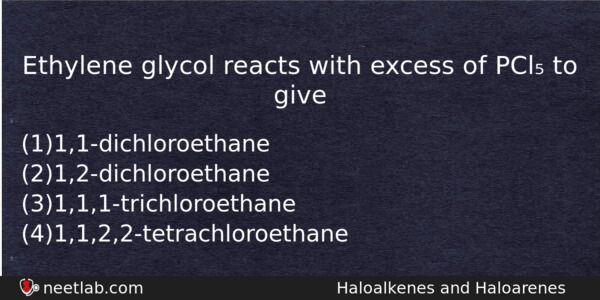| ⇦ | 
| ⇨ |
Ethylene glycol reacts with excess of PCl₅ to give
Options
(a) 1,1-dichloroethane
(b) 1,2-dichloroethane
(c) 1,1,1-trichloroethane
(d) 1,1,2,2-tetrachloroethane
Correct Answer:
1,2-dichloroethane
Explanation:
No explanation available. Be the first to write the explanation for this question by commenting below.
Related Questions: - The wavelength correspending to maximum enregy for hydrogen is 91.2 nm
- Complexes with bidentate ligands are called
- Consider the modes of transformations of a gas from state ‘A’ to state ‘B’
- Heat of combustion ΔH for C(s) , H₂(g)and CH₄(g) are -94, -68 and -213 kcal/mol.
- Which of the following is not the product of dehydration of
Topics: Haloalkenes and Haloarenes
(78)
Subject: Chemistry
(2512)
Important MCQs Based on Medical Entrance Examinations To Improve Your NEET Score
- The wavelength correspending to maximum enregy for hydrogen is 91.2 nm
- Complexes with bidentate ligands are called
- Consider the modes of transformations of a gas from state ‘A’ to state ‘B’
- Heat of combustion ΔH for C(s) , H₂(g)and CH₄(g) are -94, -68 and -213 kcal/mol.
- Which of the following is not the product of dehydration of
Topics: Haloalkenes and Haloarenes (78)
Subject: Chemistry (2512)
Important MCQs Based on Medical Entrance Examinations To Improve Your NEET Score
18000+ students are using NEETLab to improve their score. What about you?
Solve Previous Year MCQs, Mock Tests, Topicwise Practice Tests, Identify Weak Topics, Formula Flash cards and much more is available in NEETLab Android App to improve your NEET score.
Share this page with your friends

Leave a Reply